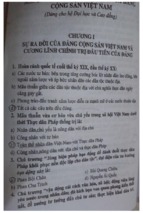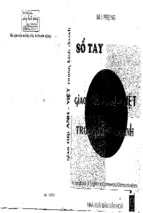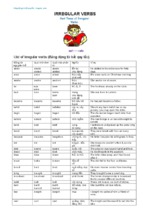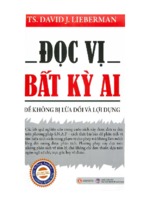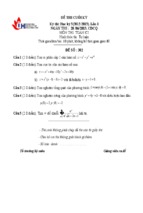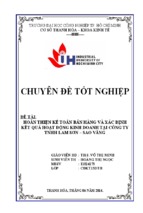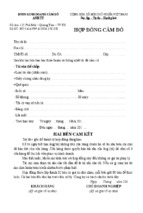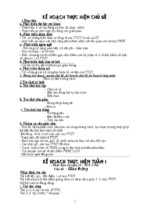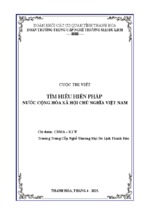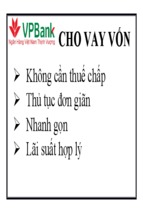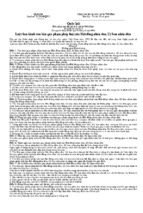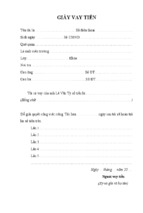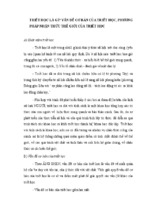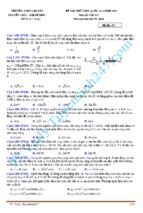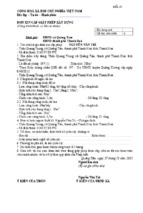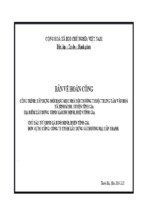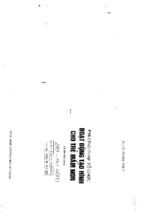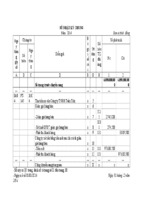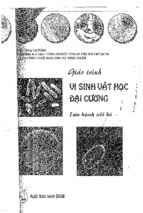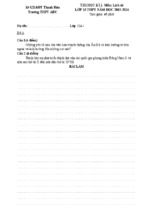NGUYỄN XUÂN THƠM
English for Pinance and
Banking
T h ế giới Publỉshers
Hanoi -1999
Bàn tiếng Việt ừi tại Việt Nam
VN-TÒ-12-525-0
Copyright @ 1999 by 'fhế Giới ĩ^ỉblishers
and Nguyễn Xuân Thcfm
V
LỜI NÓI ĐẨU
C ù n g b a h đoc yêu quý!
Xuất phát từ nhu cầu học tập và sử đụng tiếng Anh ngày
càng cao của đông đảo bạn đọc trong cả nưóc, n h ất là các bạn
sinh viên các trường đại học, chúng tòi tiến hành biên soạn
bộ sách này.
Về phương pháp biên soạn, trong bộ sách này chúng tôi
đã vận dụng các lý thuyết mới n h ất về. biên soạn chương
trình, giáo trình cho người học tiếng Anh như một ngoại ngữ.
Chúng tôi đặc biệt chú ý đến các nguyên tắc về tính vừa sức
Oearnability & teachability), tính khả dụng (validity), tính
tin cậy (reliability), tính hứng thú (interest) đốì với ngưồi
học. Chúng tôi cũng tận dụng nguyên tắc tính lợi th ế của
tiếng mẹ đè trong tiếp thu đầu vào ngôn ngữ và đánh, giá cao
vai trò của kỹ năng dịch. Dịch vừa là phương tiện rèn luyện
ngôn ngữ vừa là phuơng tiện cùng cô" kiến thức đã học.
Tên bộ sách này là T iếng Anh K ỉnh t ế - Tài chin h . Bộ
sách gồm 02 tập.
Tập I ; Tiếng Anh Kinh tế. (English for Economics)
Tâp II : Tiếng Anh Tài chính - Ngân hàng. (English for
Finance and Banking)
Cuôn sách bạn đang cầm trên tay là tập II. Chúng tôi
biên soạn nội dung cuốn sách này th àn h 10 chương bao quát
các chủ đề về tài chính và ngân hàng cộng với 03 chương ôn
tập. Mỗi chương đều đưỢc chia làm hai phần lón:
Phần 1; Bài đọc chính và hệ thống bài tập:
VI
Phần 2: Bài đọc/ Bài I^he bổ trỢ + Bài dịch r^ Ợ c và ôn tập.
Mỗi một phần của một chương cần được phân bổ một
lượng thòi gian khoảng 5-6 tiết lên lốp, mỗi chương cần từ
10-12 tiết lên lốp. Nội dung các chương có tính độc lập tương
đốì. Tuỳ đốì tưỢng, thòi gian và mục đích giảng đạy, giáo viên
có th ể dạy toàn bộ nội dung của chưđng, hoặc có th ể cắt bớt
một vài phần nhỏ hoặc cả nửa chương (phần 1 hoặc phần 2)
của chương.
1.
Xin gợi ý các bưổic lên lớp như sau:
2.
Giáo viên, dựa trên cơ sở bài đọc, trình bày các khái niệm
và giúp sinh viên hiểu các khái niệm. Vì tấ t cả các bài
đọc đều có độ dài từ 6-7 trang, giáo viên không nên trình
bày một mạch hết cả bài mà nên chia bài đọc ra thành
nhiều phần nhỏ theo các tiêu đề và kết cấu nội dung cụ
thể của từng bài.
3.
Khi trình bày xong mỗi phần của bài đọc giáo viên yêu
cầu sinh viên trả lòi câu hỏi của mình/tóm tắ t nội
dung/trình bày lại các định nghĩa. Giáo viên cung cấp các
th u ậ t ngữ tiếng Việt tương đưdng để hỗ trợ và củng cố
sự thông hiểu bài đọc của sinh viên
4.
Sinh viên thảo luận về nội dung của bài đọc theo hình
thức trình bày ý kiến cá nhân hoặc thảo luận theo nhóm
Sinh viên tóm tắ t các ý kiến th àn h các ghi chép tóm tắ'
và trìn h bày ý kiến của mình.
5‘.
Sinh viên làm sem inar nhỏ theo những chủ để lựa chọn.
6.
Sinh vịên nghe các bài giảng trên băng, làm bài tập theo
yêu cầu, viết tóm tấ t bài giảng.
V II
7.
Giáo viên hướng dẫn sinh vièn ôn tập và làm bài tập
dịch, vừa để ghi nhớ kiến thức vừa để thực hành nâng
cao kỹ năng ngón ngữ.
8.
Giáo viên hưâng dẫn sinh viên làm sổ tay thuật ngữ và
bổ sung các ví dụ minh hoạ cho cách sử dụng chuẩn mực
các th u ậ t ngộ.
Việc biên soạn một chương trình cho thật hỢp lý, phù hỢp
vói đòi hỏi nghiêm túc vể chuyên môn, vôi khả năng và mong
muốh của của người học và ngưồi dạy quả là một điều rấ t
thách thức so với khả nảng có hạn của chúng tôi. Song vì đòi
hỏi cùa tình hình, chúng tôi m ạnh dạn đưa chương trình này
vào giảng dạy. Chúng tôi đã cố gắng hết sức, song chắc chắn,
vì công việc thì lớn mà khả năng thì có hạn, nội dung và cách
trìn h bày cuốn sách này chắc hẳn không tránh khỏi những
khiếm khuyết. R ất mong được sụ chỉ giáo cùa các bậc cao
minh, các thầy cô giáo và các bạn đồng nghiệp.
Để cuốn sách có th ể ra đdi, tác giả xin chân thành cảm ơn
Tiến sỹ Nguyễn Hoà và Tiến sỹ Hoàng Vàn Vân, Khoa NNVH Anh Mỹ, ĐHNN-ĐHQG Hà nội, những ngưòi đã đọc kỹ
bản thảo cuốh sách và đà cho những ý kiến góp ý thiết thực.
Tác giả cũng xin cảm ơn Nhà xuất bản Thế giới đã biên tập
và cho xuất bản cuốh sách.
H à nội, ngày 1 tháng J nầm 1999
NGỦYỄN XUÂN THƠM
C h ủ n h iệ m B ộ m ô n N N C N
Đ H N N ■ĐHQG H à N ội
IX
T A B L E 0 F CO N TEN TS
Rle 1: Money ạhd Fỉnancia^^nstÌtution&|ỷ ị
Chapter 1
: Money and Banking
Chapter II
Chapỉer III
: Financial Institutions
Chapter IV
: Savings and Investments
stop & Check 1
ỉ Revision I
: InAation
Fite 2 : T itìá n d
Chapter V
Chapter VI
: Stock M arket (1)
: Stock M arket (2)
stop & Check II
; Revision II
'File 3 ;
Pinahcial
Chapter VII
: Corporate Pinance: Profit Accounting
Chapter VIII
Chapter IX
: Public Finance: Taxation
; Public Bìnance: National Budgeting &
National Income Accounting
Chapter X
: International Finance: Exchange Rates
stop & Check III : Revision l ỉ ỉ
This programme, when thoroughly implemented, with
adequate attention given to all the finance-related topics
X
presented in this book as well as to the ííve language skills
(listening, reading, writing, speaking and translating), will
take a t least 120 teaching periods. And this is the suggested
tim e alỉocation for the teaching of this programme;
Chapter I
: Money and Banking
Chapter II
C hapterlll
: Financial Institutions (12 periods)
: Inílation
(12 periods)
Chapter IV
: Savings and Investments (12 periods)
stop & Check I
■.Revision (TBA, To be advised)
(12periods)
Chapter V
Stock M arket (1) (12 periods)
Chapter VI
Stock M arket (2) (12periods)
stop & Check II
Revision (TBA, To be advised)
criapter VII
: Corporate Finance: Profit Accounting
(12 periods)
ChapterVii!
: Public Pinance: Taxation (12 periods)
Chapter IX
: Public Finance: National Budgeting &
National Income Accounting (12 periods)
Chapỉer X
; International PinancetExchange Rate
(12 periods)
Stop & Check ill
.Revision (TBA, To be advised)
FILE 1
MONEY AND
PINANCIAL INSTưUTIONS
E N G L IS H FOR PINANCE AND BANKING
13
C ihapter I
MONEY AND BANKING
3. What types of money do we use?
4. What are monetary standanỉs?
5. Whaỉ will future money and bạnking be like?
*
'
ị
4/
WHAT IS MONEY?
W hat ip money after all? This is a difficult question, ísn’t
it? Mr. Dombey, a character in Charles Dickens’s famous
novel “Dombey and Son" advises his son th at “Money is
powerful. Money can buy everything. Money makes us
admirable and magniĩicent in the eyes of other people”. In
the other extreme, some poets and writers may say money is
pothing; in a đay it’ll be Gnished. Conversationalists in their
cveryday chats may sometimes say money creates sins, and
at other times say money is a health-springboard for the
aged, a speed-accelerator for fame, and 80 pn and 80 forth.
14
XUÂN THƠM
However, economists who are armed with knowỉeđge and
experience in how to explain the world objectively and
scientiíically đefine money differently. According to them,
money can be anything, th a t’s ríght, anything - which people
actually accẹpt in payment for goođs and services. Several
centuries ago, N orth American cclonists used beaver pelís,
m usket balls, nails, and beads to make purchases, and to pay
for th e ữ debts.
Thus, money is anỵ medỉum o f exchange that is ividely
accepted in paym ent for goods and services and in settlemeĩit
o f debts. Money also serves as a S ta n d a r d of value for
m easuring the relative worth of different goods and services.
The num ber of un its of money required to buy a commodity
is th e price of the commodity.
WHAT DOES MONEY DO?
All modern societies use money. W ith money people can
easily trade goods and servịces with one another. T hat is
money prom otes trađẹ. Money proviđes a medium of
exchang^ a way of cừcụịating-xalue, a Standard of deferred
paym ents and a method of saving. We discuss each of these
functions of money in turn.
a. M oney as a M edium o f Exchange
Workers exchange labour services for money. People buy
or sell goods in exchange for money. Money is the međium
through wliich people exchange goods and services.
is a medium of exchange? A m edium o f exckange ỉs
anything that is lỡidely accepted ỉn paym ent for goods and
ENGLISH FOR PINANCE AND BANKING
15
services and in settlement o f debts. Money is the most
common medium of exchange.
b . M oney a s a M easure o f V alue
The second íunction of money is as a measure of value.
J u s t as we need measurements for distances, weights, and
energy, so we need measurements for the value of things
oữered at the market. Money measures value in its units of
account. The unit o f account is the unit in which prices are
quoted and accounts are kept. In Britain prices are quoted in
pound sterling. In the United States đollar, and in Vietnam
VND. The use of such units helps simplify the exchange of
goods.
c. M oney as a S to re o f V alue
The third function of money is as a store of value. Money
is a store of value because it can be used to make purchases
in the future.
d. Money as a Standard o f D eíerred Payinents
The last function of money is as a Standard of deferred
payments, or unit o f account over time. When you buy
something but do not pay for it immediately, your payment is
expressed in terms of money to be paid in the future. W ith
the wide use of installm ent buying, this function of money
has become increasingly important.
D IFFEREN T KINDS 0 F MONEY
The most im portant types of money are commodity
money, and token money.
16
XUÂN THƠM
C om m odity M oney
Commodity money ỉs a usefuỉ good that serves as a
medium o f exchange. As a result, the value of commodity
money is about equal to the value of the m a te r ia l contained
in it. The principầl materials used for this ty p e of m oney
have been gold, silver and copper.
In anciẹnt tim es various articles made of these metals, as
well as of iron and bronze, were used as money, while among
primitive peoples such comxnodities as shells, beads,
ẽĩephant tusks, furs, skins, and livestock serveíị as medium
of exchange. The gold coins in circulation in the u s before
1933 were examples of commodity money.
Token M oney
Token money ừ a means o f payment ỉvhose vaỉue or
purchasing potver as money greatly exceeds ỉts cost of
production or value in uses other than as money. A $10 note
is vvorth far more as money than as a 3x6 inch piece of high
quality paper. Simiỉarly, the monetary value of most coins
exceeds th e am ount you would get by melting them down
and selling ofĩ the m etal they contain.
MONETARY STANDARDS
We w ant to clarify two important notions: Standard
money and m onètary S tan d a rd .
W hat Ì8 Standard money? The basic money of a country,
into which other form8 of monev may be converted and which
ENGLISH FOR PINANCE AND BANKING
17
determ ines the value of other kinds of money, is called tầ e
tiioney of redemption or S t a n d a r d money.
W hat is monetary Standard? The monetary Standard of a
nation r e f e r s to the type of S ta n d a r d money u s e d in the
monetary system.
Modern monetary standarđs have been either commodity
standards, in which either gold or silver has been chieũy
useđ as S ta n d a rd money, or(^fiat stahđar<^ consisting of
ộnconvertible currenc^^aper units.
The principal types of gold S ta n d a rd are the golđ coin
Standard, the S ta n d a r d in the ư s until 1933;
poldpbụlỊÌQn
S tandard consisting of a speciíĩed q u an tity of goid; and th e
which t h e currency is
cọnỵertịble into the currency of some other country on the
golđ Standard. The gold bullion Standard was used ín Great
Britain from 192Õ to 1931, while a number of Latin
American c o u n trie s h a v e u s e d th e d o lla r e x ch a n g e S ta n d a rd .
Silver standards have been used in modern times chiefly in
the Orient.
gold
exchange
S ta n d a rd ,
under
Also ^ bimetallic Standard) has been used in some
comỉtries, under vvhich either gold or silver coins were the
Standard currency. Such systems were rarely successful
largely because of Gresham’s law, whicb describes the
tendency for cheaper money to drive more valuable money
out of cừcuIatioỊi,
Most monetary systems of the world at t^ e present time
are token (or: fíat) system; they do not allow. free
convertibility of the currency into a metgỊE5'~8tandard. and
18
XUÂN THƠM
money is given value by government edict rather than by its
nominal gold or silver content.
M odern system s are also đescribed as managed
cụrrencies, because th e value of the currency unit depends to
a considerable extent on government management and
policies. In te rnally th e m onetary system in the ưs contains
many elem ents of m anaged currency; although gold coinage
Ì8 no longer perm itted, gold may be owned, traded, or used
for in d u strial purposes. It is a recurrent problem vvhether
the value of inconvertible-credit currency can be maintained
a t a fairly stable level for extended periods of time.
M ONEY SU PPL Y
P r a c tio n a l C urrency
Pennies, nickels, dimes, quarters, and half dollars are
called frấctional currency because they are valued at a
fraction of a đollar. There are also one-dollar coins, Most
coins are token money - the value of the metal is less than the
face value of th e coin.
P a p e r M oney
From 20 to 25 percent pf th e ưs money supply is made
up of p ap er currency. The bùlk of this money is issueđ by the
Federal R eserve banks and is known as Federal Reserve
notes. All paper money is token money - th e value of the
paper u se d to m ake th e note is far less than th e face value of
th e note.
E N G LISH FO R FIN AN C E AND BANKING
19
C hecks
Paper raoney and coin account for only one fourth of the
ư s money supply. BecausS currency (paper money and coin)
can be lo s t or stolen, most money is kept on deposit in
checking accounts at banks.
People who have deposited th e ừ money in checking
accounts spend it by writing checks. A check is a w ritten
order directing a bank to pay a specified sum from one
person’s account to another person or to a business.
T ra veller's C hecks
Travellers know ,that it is oíten difficult to use their
personal checks in places they are riot known. B ut most
people do not waiit to carry a lot of cash on business trips
because it can easily be lọst or stolen. One solution to this
problem is to use traveller’s checks. Most large banks sell
these checks.
Traveller’s checks are widely accepted as paym ent in
many countries. The table belovv shows the kinds and
amounts of money in cừculation in the u s in a recent year
N ea r M oney
You now know w hat money is, however, it may surprise
ỵou to learn th a t our definition of money supply given in the
prbvious part is a very narrow one. In fact, ứie definition of
money changes from time to time.
20
XUÂN THƠM
T a b le I . l : K in d s a n d a m o u n ts o f m o n e y in c ir c u la t io n
in t h e
us. i n B r e c e n t y e a r
United S tates Money Supply, 1988 (biỉỉioas)
Checking accồUHte
$555
Paper money and coin
S201
Traveller^s cbecks
$7
S763
N arrow ly defĩned, money consists of transaction
baỉances - th e money held by the public to use for
c u rre n t spending. Such money is usually called M1, and
M l is m ade up of (1) coins, (2) paper currency, (3)
dem and deposits and (4) other checkable deposits (e.g.
NOW accounts and sh are d ra íts in credit unions) and
tra v e lle r’s checks.
In ađdition to these items, families and businesses hold
large am ount of assets th a t sometimes act like money ev en
though they fail to meet our narrow definition of money.
Such assets are called near-money.
Although these assets can not be used immediately to
buy goods or services, they can be\converted intoimoney vẹry
easily. These liquid assets include savin,gs accounts at thriít
institutions such as savings banks, shares in money market
' m utual fundầ, time deposits a t commercial banks, and
èavings bonds. Tỉiese and other similar assets do not
circulate in the way th a t currency and checks circulate, but
they m ust be consideređ in analyzing people’s spendmg
habits an'đ in aồsesÉÌng the relationship between the money
supply and the price level.
ENGLISH FOR PINANCE AND BANKING
21
There are several measures th at include these near
Moines - M2, M3 and L (the letter L stands for lÌQUidity or
overall ability to spenđ), of which L is ứie broadest measure; it
shows the ability of all sectors of the economy to spend. But you
necd not be worried about the components of each of these
measures; they are the concems of monetary proíessionals.
T a b le ỉ ^ : C u r r e n t M o n e y S u p p ly in t h e u s .
m
1. C urrency (including com) in the hand of the publỉc
2. Traveller*Ễ checks
3. Demanđ đeposits (balaaces in checking accounts)
4. Bâlances in NOW and super-NOW accounts
5. Đalaoces in accounts witk Automatic Transíer Service (ATS)
6. Balaoces in credit unioa share draft accoimts
M2 s M l plus
1. Savings and sm all tim e deposits (less than $100,000) at depository
institutions
2. Overnight repurchase agreem ents (*) at commercial banks
3. Certain Eurodoỉỉars (**) deposits
4. Shares in money market^mutual ỉnnẻ^ held primariỉy by houdeholds
and small businẹsses.
M3= M2 plus
1. Lai^e time deposits ( $100, 000 t)r more) at depository institutiocs
2. Repưrchase agreements with m attưitỉes ỉonger than one đay at
commerciaỉ banks and savings and loans associations
3. Shares iỉi money market mutual funds that are used by large tlnancial
institutions and Corporation s.
22
XUÂN THƠM
(*) O vem ^ h t repurchase agreement« (RPs) are the sale of ẳecurìties, with
a sim ultaneous agreemenỆ by the selỉer to repurchase tb e n a t an
agreed-upoD price. L a x ^ institutioDS use B P s to invest idle fim(ụ for
short perỉods, ỉirequentỉỵ One day. Because o v em ^ h t RPs have such a
ehort iDaturíty, they are viewed as mooey.
(**) Euro dolỉars are doUars which are deposi^d in baoking otnces outside
the United States.
(Source: Pedenã Reaerve Bank o f Nete York)
In this book, when we use the term “money” vre are
referring to MI (Ml Ì8 included in M2, M3, and L. Thus only
the portion of each measure that exceeds M l can be calleđ
near-money)
WHAT WILL TOM OKRO^S BANKING BE LIKE?
The electronic revolution which has brought U8 CAL
(Computer assỉsteđ ỉearning), CD Roms and viđeo games ịs at
the same time bringing about major changes in the way
people use money ạnd credit to pay for things they buy.
E lectronic F u n d Transỷer
An electronic funds transfer (EFT) system uses computera
and automated equipment to receive and make payments.
EPT oíĩers certain ađvantagea over checks. When people
deposit checks at their lianks, it normally takes a few days
for the amount to be cređiteđ to their account. Depositors can
not witỉỉdraw and spend those amounts untiỉ their account Ì8
credited. EFT payments, however, are credited immediately.
Credits are made electronically (via telecomputers) to a
personal or business bark account. Consequently, depositors
ENGLtSH FOR PINANCE AND BANKING
23
can spend money on the same đay they put the money into
their a
- Xem thêm -


